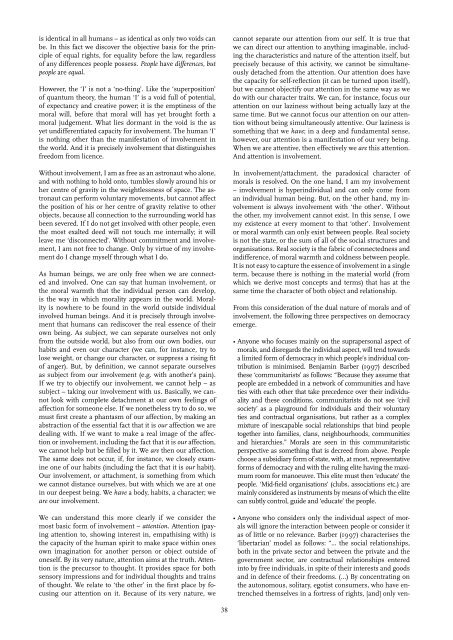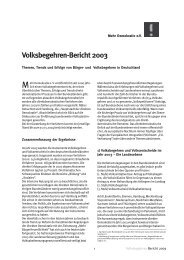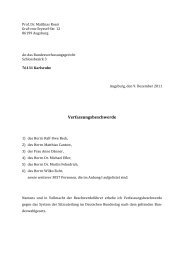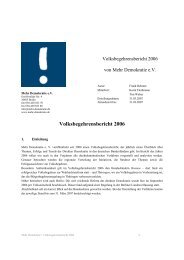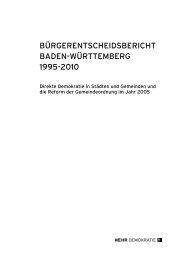Facts and Arguments about the Introduction of Initiative and ...
Facts and Arguments about the Introduction of Initiative and ...
Facts and Arguments about the Introduction of Initiative and ...
You also want an ePaper? Increase the reach of your titles
YUMPU automatically turns print PDFs into web optimized ePapers that Google loves.
is identical in all humans – as identical as only two voids can<br />
be. In this fact we discover <strong>the</strong> objective basis for <strong>the</strong> principle<br />
<strong>of</strong> equal rights, for equality before <strong>the</strong> law, regardless<br />
<strong>of</strong> any differences people possess. People have differences, but<br />
people are equal.<br />
However, <strong>the</strong> ‘I’ is not a ‘no-thing’. Like <strong>the</strong> ‘superposition’<br />
<strong>of</strong> quantum <strong>the</strong>ory, <strong>the</strong> human ‘I’ is a void full <strong>of</strong> potential,<br />
<strong>of</strong> expectancy <strong>and</strong> creative power; it is <strong>the</strong> emptiness <strong>of</strong> <strong>the</strong><br />
moral will, before that moral will has yet brought forth a<br />
moral judgement. What lies dormant in <strong>the</strong> void is <strong>the</strong> as<br />
yet undifferentiated capacity for involvement. The human ‘I’<br />
is nothing o<strong>the</strong>r than <strong>the</strong> manifestation <strong>of</strong> involvement in<br />
<strong>the</strong> world. And it is precisely involvement that distinguishes<br />
freedom from licence.<br />
Without involvement, I am as free as an astronaut who alone,<br />
<strong>and</strong> with nothing to hold onto, tumbles slowly around his or<br />
her centre <strong>of</strong> gravity in <strong>the</strong> weightlessness <strong>of</strong> space. The astronaut<br />
can perform voluntary movements, but cannot affect<br />
<strong>the</strong> position <strong>of</strong> his or her centre <strong>of</strong> gravity relative to o<strong>the</strong>r<br />
objects, because all connection to <strong>the</strong> surrounding world has<br />
been severed. If I do not get involved with o<strong>the</strong>r people, even<br />
<strong>the</strong> most exalted deed will not touch me internally; it will<br />
leave me ‘disconnected’. Without commitment <strong>and</strong> involvement,<br />
I am not free to change. Only by virtue <strong>of</strong> my involvement<br />
do I change myself through what I do.<br />
As human beings, we are only free when we are connected<br />
<strong>and</strong> involved. One can say that human involvement, or<br />
<strong>the</strong> moral warmth that <strong>the</strong> individual person can develop,<br />
is <strong>the</strong> way in which morality appears in <strong>the</strong> world. Morality<br />
is nowhere to be found in <strong>the</strong> world outside individual<br />
involved human beings. And it is precisely through involvement<br />
that humans can rediscover <strong>the</strong> real essence <strong>of</strong> <strong>the</strong>ir<br />
own being. As subject, we can separate ourselves not only<br />
from <strong>the</strong> outside world, but also from our own bodies, our<br />
habits <strong>and</strong> even our character (we can, for instance, try to<br />
lose weight, or change our character, or suppress a rising fit<br />
<strong>of</strong> anger). But, by definition, we cannot separate ourselves<br />
as subject from our involvement (e.g. with ano<strong>the</strong>r’s pain).<br />
If we try to objectify our involvement, we cannot help – as<br />
subject – taking our involvement with us. Basically, we cannot<br />
look with complete detachment at our own feelings <strong>of</strong><br />
affection for someone else. If we none<strong>the</strong>less try to do so, we<br />
must first create a phantasm <strong>of</strong> our affection, by making an<br />
abstraction <strong>of</strong> <strong>the</strong> essential fact that it is our affection we are<br />
dealing with. If we want to make a real image <strong>of</strong> <strong>the</strong> affection<br />
or involvement, including <strong>the</strong> fact that it is our affection,<br />
we cannot help but be filled by it. We are <strong>the</strong>n our affection.<br />
The same does not occur, if, for instance, we closely examine<br />
one <strong>of</strong> our habits (including <strong>the</strong> fact that it is our habit).<br />
Our involvement, or attachment, is something from which<br />
we cannot distance ourselves, but with which we are at one<br />
in our deepest being. We have a body, habits, a character; we<br />
are our involvement.<br />
We can underst<strong>and</strong> this more clearly if we consider <strong>the</strong><br />
most basic form <strong>of</strong> involvement – attention. Attention (paying<br />
attention to, showing interest in, empathising with) is<br />
<strong>the</strong> capacity <strong>of</strong> <strong>the</strong> human spirit to make space within ones<br />
own imagination for ano<strong>the</strong>r person or object outside <strong>of</strong><br />
oneself. By its very nature, attention aims at <strong>the</strong> truth. Attention<br />
is <strong>the</strong> precursor to thought. It provides space for both<br />
sensory impressions <strong>and</strong> for individual thoughts <strong>and</strong> trains<br />
<strong>of</strong> thought. We relate to ‘<strong>the</strong> o<strong>the</strong>r’ in <strong>the</strong> first place by focusing<br />
our attention on it. Because <strong>of</strong> its very nature, we<br />
3<br />
cannot separate our attention from our self. It is true that<br />
we can direct our attention to anything imaginable, including<br />
<strong>the</strong> characteristics <strong>and</strong> nature <strong>of</strong> <strong>the</strong> attention itself, but<br />
precisely because <strong>of</strong> this activity, we cannot be simultaneously<br />
detached from <strong>the</strong> attention. Our attention does have<br />
<strong>the</strong> capacity for self-reflection (it can be turned upon itself),<br />
but we cannot objectify our attention in <strong>the</strong> same way as we<br />
do with our character traits. We can, for instance, focus our<br />
attention on our laziness without being actually lazy at <strong>the</strong><br />
same time. But we cannot focus our attention on our attention<br />
without being simultaneously attentive. Our laziness is<br />
something that we have; in a deep <strong>and</strong> fundamental sense,<br />
however, our attention is a manifestation <strong>of</strong> our very being.<br />
When we are attentive, <strong>the</strong>n effectively we are this attention.<br />
And attention is involvement.<br />
In involvement/attachment, <strong>the</strong> paradoxical character <strong>of</strong><br />
morals is resolved. On <strong>the</strong> one h<strong>and</strong>, I am my involvement<br />
– involvement is hyperindividual <strong>and</strong> can only come from<br />
an individual human being. But, on <strong>the</strong> o<strong>the</strong>r h<strong>and</strong>, my involvement<br />
is always involvement with ‘<strong>the</strong> o<strong>the</strong>r’. Without<br />
<strong>the</strong> o<strong>the</strong>r, my involvement cannot exist. In this sense, I owe<br />
my existence at every moment to that ‘o<strong>the</strong>r’. Involvement<br />
or moral warmth can only exist between people. Real society<br />
is not <strong>the</strong> state, or <strong>the</strong> sum <strong>of</strong> all <strong>of</strong> <strong>the</strong> social structures <strong>and</strong><br />
organisations. Real society is <strong>the</strong> fabric <strong>of</strong> connectedness <strong>and</strong><br />
indifference, <strong>of</strong> moral warmth <strong>and</strong> coldness between people.<br />
It is not easy to capture <strong>the</strong> essence <strong>of</strong> involvement in a single<br />
term, because <strong>the</strong>re is nothing in <strong>the</strong> material world (from<br />
which we derive most concepts <strong>and</strong> terms) that has at <strong>the</strong><br />
same time <strong>the</strong> character <strong>of</strong> both object <strong>and</strong> relationship.<br />
From this consideration <strong>of</strong> <strong>the</strong> dual nature <strong>of</strong> morals <strong>and</strong> <strong>of</strong><br />
involvement, <strong>the</strong> following three perspectives on democracy<br />
emerge.<br />
• Anyone who focuses mainly on <strong>the</strong> suprapersonal aspect <strong>of</strong><br />
morals, <strong>and</strong> disregards <strong>the</strong> individual aspect, will tend towards<br />
a limited form <strong>of</strong> democracy in which people’s individual contribution<br />
is minimised. Benjamin Barber (1997) described<br />
<strong>the</strong>se ‘communitarists’ as follows: “Because <strong>the</strong>y assume that<br />
people are embedded in a network <strong>of</strong> communities <strong>and</strong> have<br />
ties with each o<strong>the</strong>r that take precedence over <strong>the</strong>ir individuality<br />
<strong>and</strong> <strong>the</strong>se conditions, communitarists do not see ‘civil<br />
society’ as a playground for individuals <strong>and</strong> <strong>the</strong>ir voluntary<br />
ties <strong>and</strong> contractual organisations, but ra<strong>the</strong>r as a complex<br />
mixture <strong>of</strong> inescapable social relationships that bind people<br />
toge<strong>the</strong>r into families, clans, neighbourhoods, communities<br />
<strong>and</strong> hierarchies.” Morals are seen in this communitaristic<br />
perspective as something that is decreed from above. People<br />
choose a subsidiary form <strong>of</strong> state, with, at most, representative<br />
forms <strong>of</strong> democracy <strong>and</strong> with <strong>the</strong> ruling elite having <strong>the</strong> maximum<br />
room for manoeuvre. This elite must <strong>the</strong>n ‘educate’ <strong>the</strong><br />
people. ‘Mid-field organisations’ (clubs, associations etc.) are<br />
mainly considered as instruments by means <strong>of</strong> which <strong>the</strong> elite<br />
can subtly control, guide <strong>and</strong> ‘educate’ <strong>the</strong> people.<br />
• Anyone who considers only <strong>the</strong> individual aspect <strong>of</strong> morals<br />
will ignore <strong>the</strong> interaction between people or consider it<br />
as <strong>of</strong> little or no relevance. Barber (1997) characterises <strong>the</strong><br />
‘libertarian’ model as follows: “... <strong>the</strong> social relationships,<br />
both in <strong>the</strong> private sector <strong>and</strong> between <strong>the</strong> private <strong>and</strong> <strong>the</strong><br />
government sector, are contractual relationships entered<br />
into by free individuals, in spite <strong>of</strong> <strong>the</strong>ir interests <strong>and</strong> goods<br />
<strong>and</strong> in defence <strong>of</strong> <strong>the</strong>ir freedoms. (…) By concentrating on<br />
<strong>the</strong> autonomous, solitary, egotist consumers, who have entrenched<br />
<strong>the</strong>mselves in a fortress <strong>of</strong> rights, [<strong>and</strong>] only ven-


